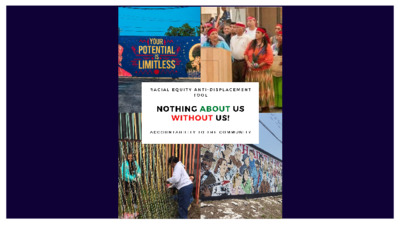Item3a_Racial Equity Anti-Displacement Tool Briefing Presentation — original pdf
Backup

Background The Co-creation Team & Model Community Catalysts ● 30 people selected from a pool of 117 applicants. They are being compensated for their time ● Participants were selected based on displacement risk ● Catalyst group model used to center voices of people with lived experience and greatest risk of displacement 2 Evidence of Displacement: Central East Austin 17% Black 83% White 12% Black 23% Hispanic 62% White Source: “Austin Restricted” (Tretter, 2012) from U.S. Census data 8% Black 35% Hispanic 49% White 3 Evidence of Transit Oriented Displacement: Portland, OR 4 Vision With the help of the Equity Tool, we envision: Austin renowned for its strong communities and inclusive neighborhoods. It's economic and racial diversity as the foundation which fuels the City's innovative and entrepreneurial spirit. Austin that welcomes all incoming ethnic groups, new BIPOC transplants, and values its Native and long time BIPOC residents, businesses and community organizations. We see a future in which Austinites, regardless of race or means, thrive with the power to determine their futures. 5 Racial Equity Drivers Driver One: Prevent Residential, Commercial, and Community Displacement Driver Two: Advance Economic Mobility and Opportunity Driver Three: Build on Local Cultural Assets Driver Four: Promote Transportation Mobility and Connectivity Driver Five: Develop Healthy and Safe Neighborhoods Driver Six: Equitable Access to All Neighborhoods 6 People Black, Indigenous, and People of Color at risk of displacement 7 Places Displacement Risk Areas Image from the Project Connect Racial Equity Anti- Displacement Map Tool showing displacement risk categories and Project Connect lines (Link to online map: https://arcg.is/qr G8C) 8 Places Displacement Risk Areas Image from the Project Connect Racial Equity Anti- Displacement Map Tool showing displacement risk areas within 1 mile of a Project Connect station (Link to online map: https://arcg.is/qrG 8C) 9 Purposes Balanced Allocation Priorities for the Anti- Displacement Fund A balanced approach is needed to address the long history of public and private disinvestment in communities of color Illustration created by Racial Equity Catalyst Jasmine Willis 10 Racial Equity Anti-Displacement Tool Five sections: Community-Driven I. II. Community Priorities III. Community Guardrails IV. Reasonableness (funds only) V. Balanced Portfolio (funds only) Scoring criteria for each section informs project design and funding awards. Each criterion is scored on a range from 5 points for a strong response to 0 points for a weak response. 11 I. Community-Driven Does this proposal advance the community’s vision of racially equitable development, and is it accountable to them? 12 II. Community Priorities: People, Place, Purpose Does this proposal meaningfully decrease displacement pressure for those populations, businesses and cultural anchors most at risk? 13 III. Community Guardrails Does this proposal address unintended consequences that may result in additional harms to BIPOC residents, business, and community organizations? -. 14 IV. Reasonableness (fund only) Is this proposal likely to be successfully implemented? 15 V. Balanced Portfolio (fund only) Do all proposals reflect a balance of priority populations, places, and purposes? 16 Community-Led Implementation and Accountability The Process of Continuous Improvement OPERATIONALIZE Evaluate the tool in practice. How effective is the tool in helping to prevent displacement? What did we learn? What are opportunities for improvement? NORMALIZE Understand the history and context. Get familiar with and apply the tool. Racial Equity Lens ORGANIZE Feedback loops, workshopping the tool, adjusting tool in response to changing needs from directly impacted communities 18 Attend a Learning Session this Fall bit.ly/AntiDisplacementLearningSessions 19 Thank you!